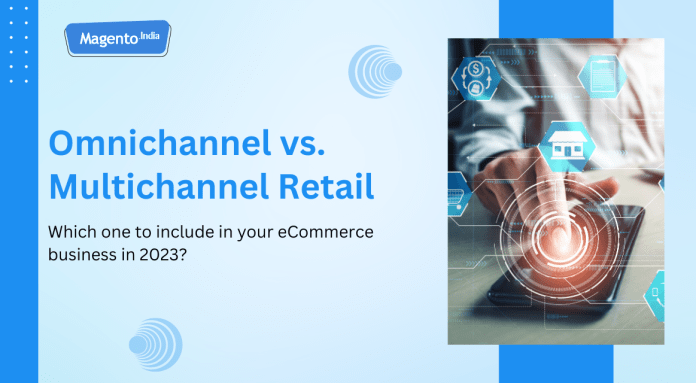In the ever changing worlds of eCommerce, and digital marketplaces, customer experience plays the most important role. To ensure your business offers best customer experience, omnichannel and multichannel retail comes in. Both have similar set of goals but they are different in their operations.
For eCommerce industry Omnichannel vs multichannel retail are popular approaches where different digital assets are integrated to engage prospects for higher ROI. Below, we’ll discuss the information you must consider to decide which is better for your business growth.
Introduction to Omnichannel
Omnichannel business approach focuses on customer oriented sales strategy to offer a smooth shopping experience between different marketing channels. The major channels to sell includes desktops, mobile devices, and brick-n-mortar store. Customers can make a purchase from any location instead of depending on any specific channels. Omnichannel ensures no compromise is present for customer experiences within and between channels.
Pros of Omnichannel
- Personalized customer services and higher loyalty
- Real-time data collection and processing
- Improved ROI and sales number
Limitations of Omnichannel
- Needs expertise and regular update in technology infrastructure
- Difficult implementation and management
- Regular structuring of organization
Introduction to Multichannel
A multichannel strategy combines the customer experience and gives them different channels as per their preference. It’s flexible eCommerce solution for retail industry but brands need to operate in the limitations of the channel. You can sell your product through different channels, where each channel offers a separate and independent opportunity. After having insights regarding the best channel bringing results, you can optimize those channels for engagement.
Pros of Multichannel
- Higher reach and brand visibility
- Easy model to target different customer groups
- Different touchpoints available for engagement
Limitations of Multichannel
- Inconsistent customer experience
- Challenges in tracking and monitoring performance
- Limited channels integration
Omnichannel vs Multichannel Differences
Omnichannel strategy works on the multichannel foundation, there are important differences in terms of the customer experience, business objectives and execution.
Focused Area
An Omnichannel strategy works by keeping a check on identifying all the major point of contacts between a customer and a brand. Later it works on improving the moments to bring convenience for the customer while making any purchase. In a multichannel approach, businesses focus on placing products to multiple customers, but the focus is on growing the online presence, not on customer experience.
Customer Experiences
Implementing different channel capabilities supports business brands to build new and memorable customer experiences. This is not possible through a single channel. With the multichannel approach, customers avail products they are looking for and can buy from their preferred channel. The major example to include is the Amazon but your business exposure is limited to that particular website. The brand can consult eCommerce website development company to incorporate the Amazon selling into a robust omnichannel strategy.
Contact Channels
Another major difference between the two approach to consider is the number of contact channels available vs the quality of support from every channels. Multichannel is focused on increasing the number of channels present. It is considered that more channels provided, the outcome is better. It improves the reach and supports customers with different engagement models. However, there is no link between the channels, meaning to avail support from different resource, customer need to switch. This lowers the quality standard.
For example, if a customer during the buying process face difficulty to log into their account, they connect customer service provider. The service agent suggest the process to change password. Once the call is over and the customer implements the steps, however, they face a step not described. They switch the support process and share the screenshot of step to customer service via email. As both email and phone support is not synced, the customer need to share detail of problem from the start.
Omnichannel focuses on quality of support provided to concern customer over a business’ channel. A customer has different options for support services and get similar sort of quality support from all channels. There is a big difference between quality of support and kind of support. With Omnichannel approach it is not defined that every channel provides the same type of support. Contact channels are different to deal with the different sorts of support a customer might require.
Also view: Business Benefits Of Omnichannel Retail Management
Omnichannel vs Multichannel Retail: Which to Choose?
The choice between omnichannel retail management solutions vs multichannel business completely depends on the business objectives, budget, and marketing strategy. Each channel offers different benefits including inventory management, customer engagement to operational cost.
Multichannel is fruitful if you’re looking to expand your business reach but it involves regular investment in the long run when different business channels are added. Monitoring inventory is also a challenge to address.
Omnichannel requires more efforts and cost to set up, but inventory management and offering quality customer experience are a lot easier. It is so because everything is managed from one place.
Wrapping Up
With omnichannel retail it becomes simple to link brick-and-mortar stores with online channels for personalized customer experiences. The goal is to improve customer buying experience and personalize the whole journey for higher engagement.
A multichannel approach uses different channels to put a brand’s products for valuable shoppers. There is limited integration, so the product data synced ensure that product listings are consistently updated. This still needs investment for the right technology to make adoption simplified. Both approaches are focused on improving the customer satisfaction, but they are complex to manage. With the proper planning and expertise of the best eCommerce development company in India, can be highly rewarding for a business.
